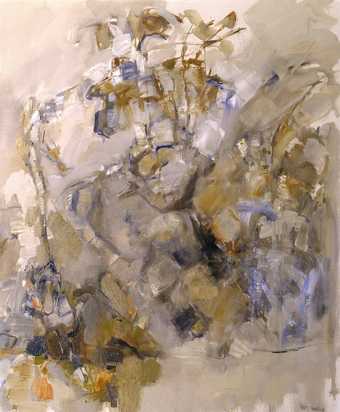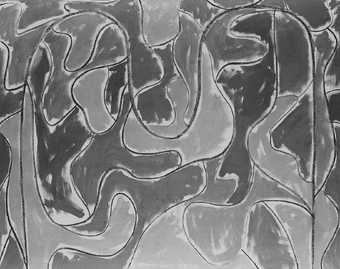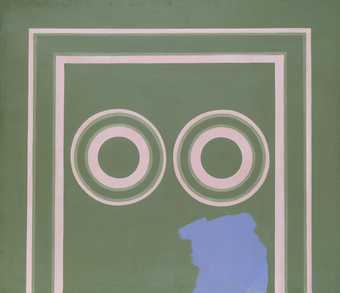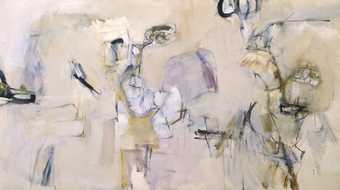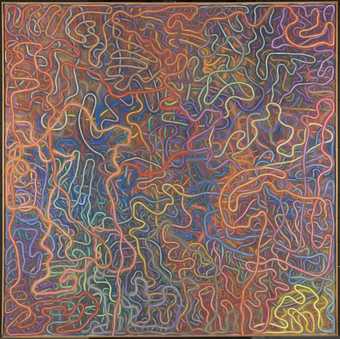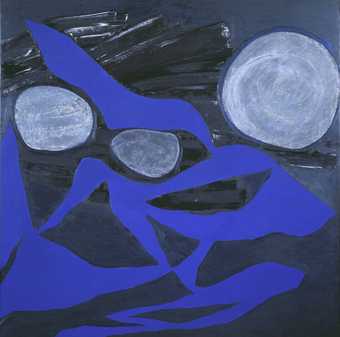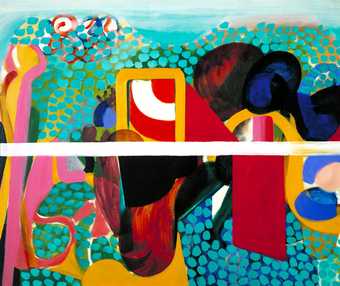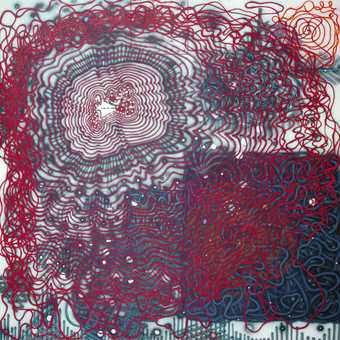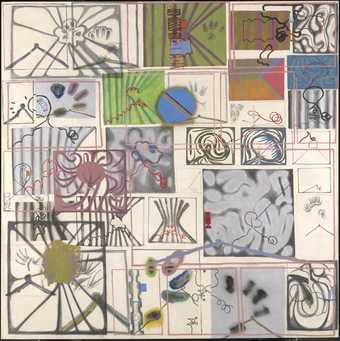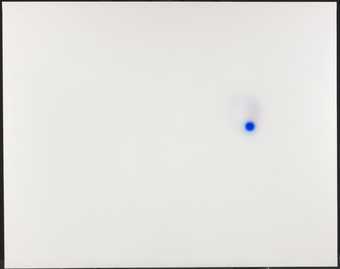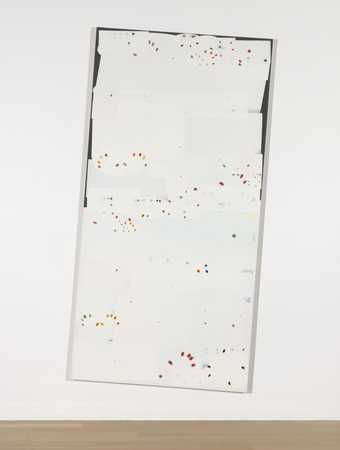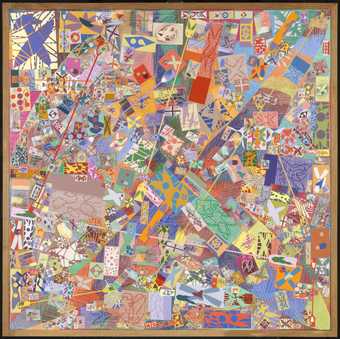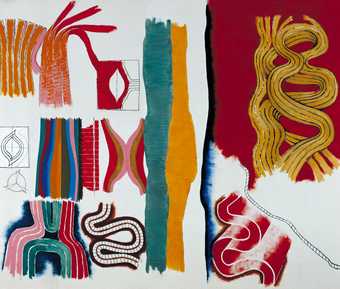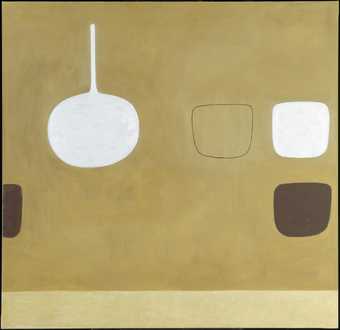
Not on display
- Artist
- Bernard Cohen born 1933
- Medium
- Oil paint and tempera on canvas
- Dimensions
- Support: 2438 × 3048 × 37 mm
- Collection
- Tate
- Acquisition
- Purchased 1972
- Reference
- T01536
Display caption
Like Cohen's 'In that Moment', also in this display, this painting is a homage to the French writer Albert Camus. It refers in particular to Camus's confessional novel 'The Fall' of 1956, which it echoes in being an uninterrupted monologue. It also continues Cohen's fascination with cooking, which, like painting, is a procedure and a selection of ingredients before it results in an end product. Here food is imagined piled on a plate too big to fit into the rectangle, which Cohen deliberately subverts by tilting the angle of the image. On top of the food is a 'sauce' made of all the painting's colours mixed together. Before using colours Cohen painted the whole surface thickly with white paint, creating protruding ridges. He then sprayed the colour. His final acts were to rip off the masking tape which formed the plate's diagonal base (thus revealing the painting's first ground) and then to scrape off the cake-icing-like ridges of the white paint, producing 'turbulence' overall.
Gallery label, September 2004
Does this text contain inaccurate information or language that you feel we should improve or change? We would like to hear from you.
Catalogue entry
Bernard Cohen b.1933
T01536 Fall 1964
Not inscribed.
Oil and egg tempera on canvas, 96 x 120 (244 x 305).
Purchased from the Waddington Galleries (Grant-in-Aid) 1972.
Coll: The artist.
Exh: Group exhibition, Kasmin Ltd, August–September 1964; Hayward Gallery, April–May 1972 (38,repr. in colour).
Lit: David Thompson, ‘Art’, in Queen, 26 August 1964; Patrick Procktor, ‘Fall into Fondant’, in New Statesman, 11 September 1964; Richard, Morphet, in catalogue of Hayward Gallery exhibition 1972 (see above), p.20.
The following notes, based on conversations with the artist in 1971, have been approved by him.
T01536 was one of a group of paintings made early in 1964. It came soon after ‘Pie’ 1964, a work of the same media and slightly larger dimensions (96 x 132 in.), which is reproduced in the Hayward Gallery catalogue, op cit., and with which it shares a concern with food. ‘Pie’‘represents’ a pie which, extending right across the lowest quarter of the picture surface, ‘rests’ on the lower edge of the canvas. Its ‘ingredients’ are individual panels, a device established earlier in works such as T01535, and these are surmounted by a painted ‘crust’. In T01536, the analogy is with food piled high on a plate. Being too big to fit into the rectangle in a conventional orientation, the plate of food is tilted sideways. The ‘crust ‘of ‘Pie’ is paralleled by the ‘sauce’ which in T01536 covers the food on the plate. Both ‘crust’ and ‘sauce’ were painted in an amalgam of all the colours that had been used to paint the rest of the picture.
Cohen’s work of the mid 1960s shows frequent involvement with gastronomic themes. T01162,‘Floris’ 1964, is named after a London patisserie. Cohen is interested in certain analogies between painting and cooking. His work shows continuous concern with the notion of hybrid (the bringing together of disparate elements into a new whole), with that of craft, and with the priority of process and its revelation in a painting over any direct intention of image-making. Hence in the ‘food’ paintings such as T01536 the individuality of the elements in the dish is asserted equally with their fusion into a new entity, the work’s elaborate graphic complexity has analogies with cake decoration and (in tactile, ‘carved’ white areas of T01536) with cake icing—both of which continue long craft traditions—and the food analogy emphasises that a cooked dish is a construction before it is something to eat. The title of T01536 refers neither to a season nor to the gradient but to Camus’s book of the same name concerning the fall of man. The artist added in a letter dated 4 June 1974 that ‘for a long time I had loved die book and I suppose that naming the painting after it was an act of homage to Camus. After ten years I can see that there were structural similarities between book and painting. The book is in the form of an uninterrupted monologue. It is a public confession and as such seeks to illuminate the nature of personal crisis.
‘The painting, worked non-stop over a period of four days within a deteriorating physical situation (the rapidly drying paint) demanded that I found thoughts and forms in rapid succession. So a kind of jumbled monologue took place and was forced along, over and over upon itself until a visual and physical crisis was reached.’
In the early 1960s, when the shaped canvas was much discussed, Cohen repeatedly used different pictorial devices to reaffirm the rectangular format. But several lozenge-shaped canvases, the scattered layout of the panel paintings (e.g., T01535) and his growing concern with layers of paint in depth all betokened a wish while retaining the rectangle, to escape its dominance. This wish underlay the design of T01536, where the rectangle of the picture plane is sharply bisected into two triangular areas that are given dramatically contrasting chromatic weight.
T01536 was closely followed by twin canvases of lozenge format, and from 1973 Cohen began to make rectangular paintings such as T01867 ‘Zany Balances’ 1973–4 which are hung on individually specified diagonals not at 45 degrees to the upright.
In T01536, Cohen continued an earlier practice of mixing his paints on the picture plane, leaving the deposits of the mixing as part of the finished work. In this picture sprayed discs, which would be prominent in Cohen’s work from 1966, make an early appearance. The creation of marks by the removal of tapes, after painting was well-advanced, was an important feature of a whole group of Cohen’s works in 1964. Morphet, loc. cit., gives a detailed account of the techniques, and their sequence, employed in painting T01536.
Published in The Tate Gallery Report 1972–1974, London 1975.
Explore
- abstraction(8,615)
-
- from recognisable sources(3,634)
- non-representational(6,161)
-
- colour(2,481)
- irregular forms(2,007)
You might like
-
Robert Medley A Tree Study
1959 -
Martin Froy Two Figures Summer ‘61
1961 -
Bernard Cohen Phoenix
1961 -
Bernard Cohen Early Mutation Green No. II
1960 -
Robert Medley Figuration on White
1963 -
Bernard Cohen In That Moment
1965 -
Ceri Richards La Cathédrale Engloutie (Arabesque 3)
1961 -
Howard Hodgkin Dinner at West Hill
1964–6 -
Bernard Cohen Floris
1964 -
Bernard Cohen Matter of Identity I
1963 -
Bernard Cohen Blue Spot
1966 -
Bernard Cohen Zany Balances
1973–4 -
Bernard Cohen Matter of Identity III - The Trace
1977–9 -
Harold Cohen Before the Event
1963 -
William Scott Permutations Ochre
1978

